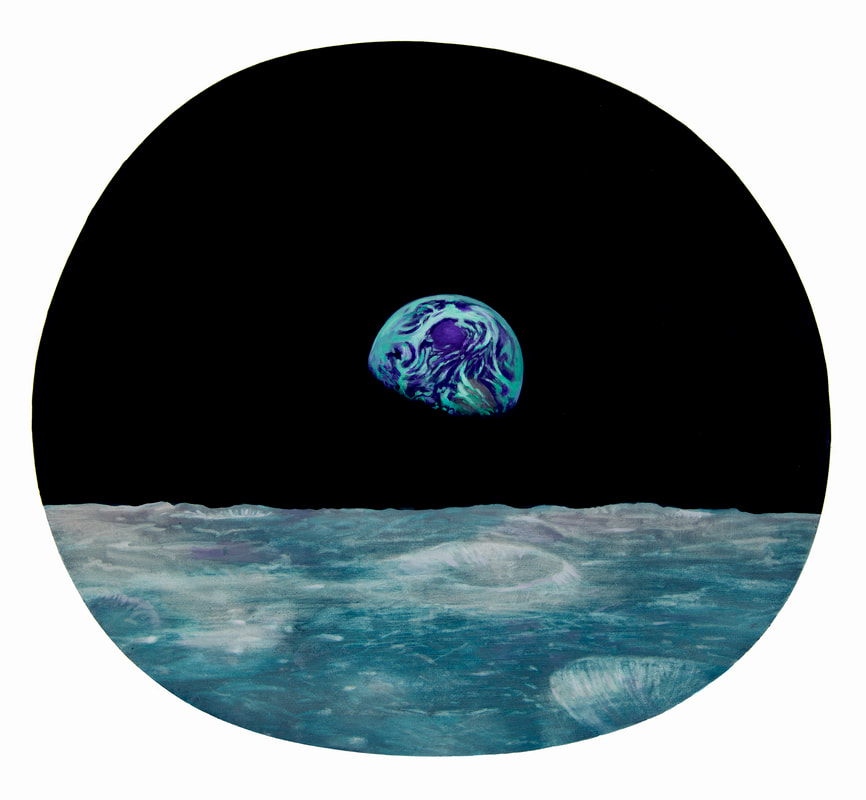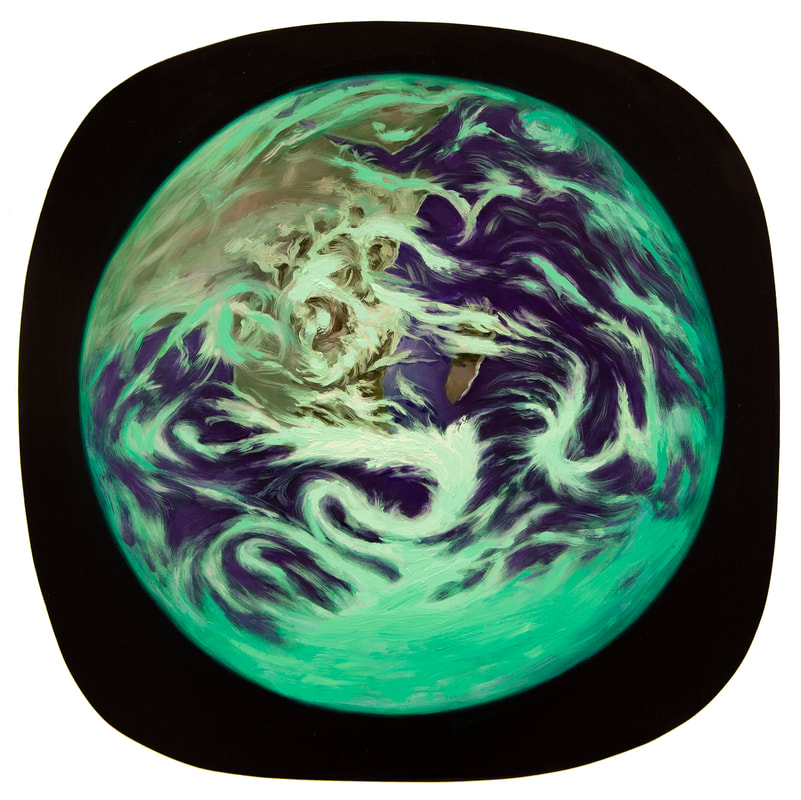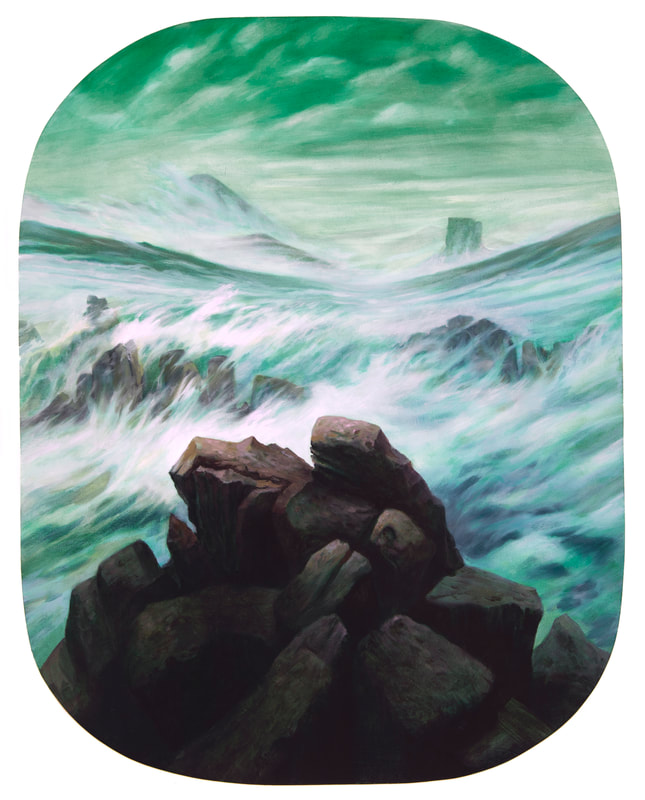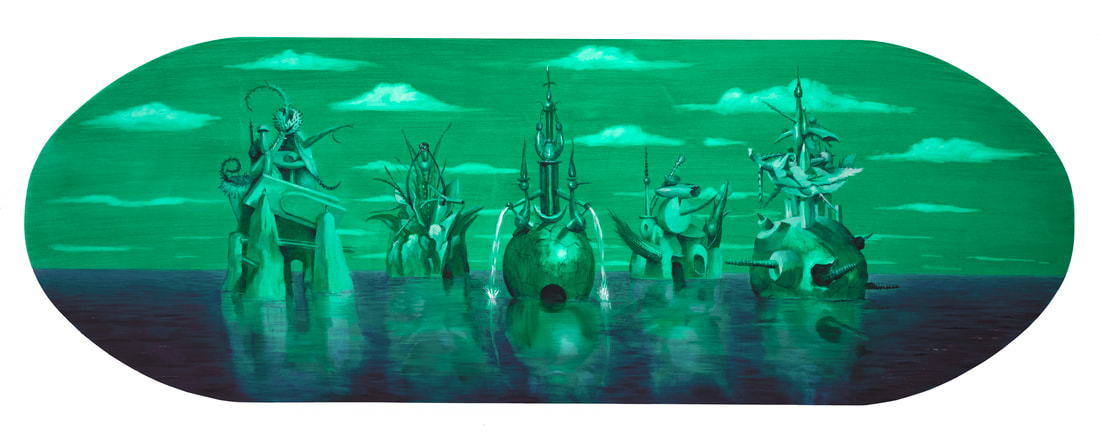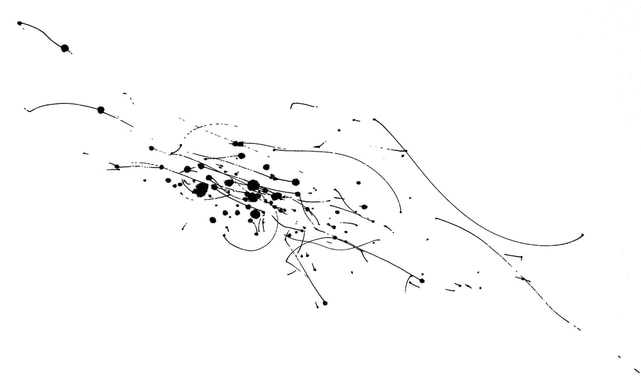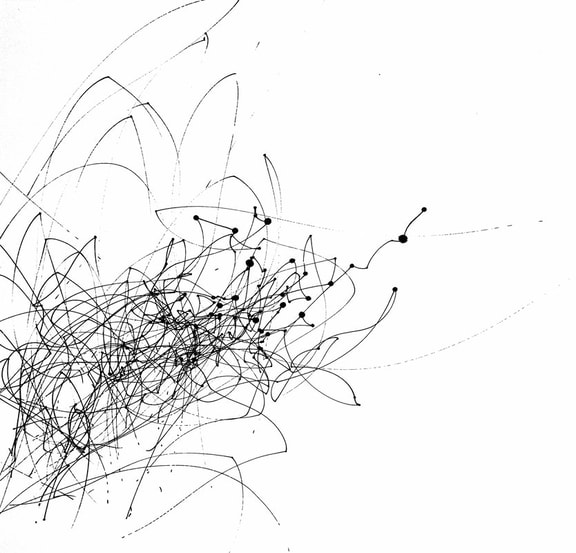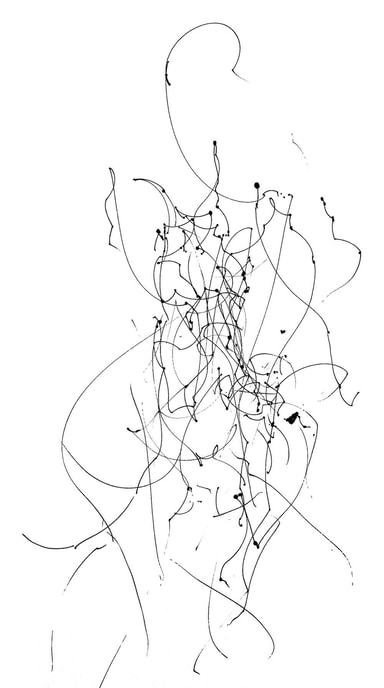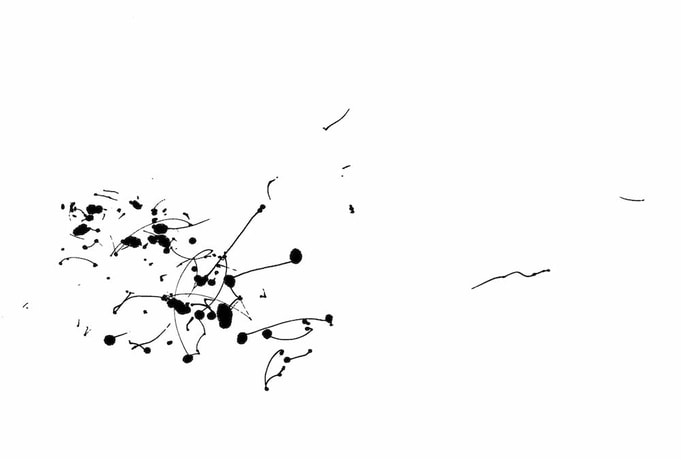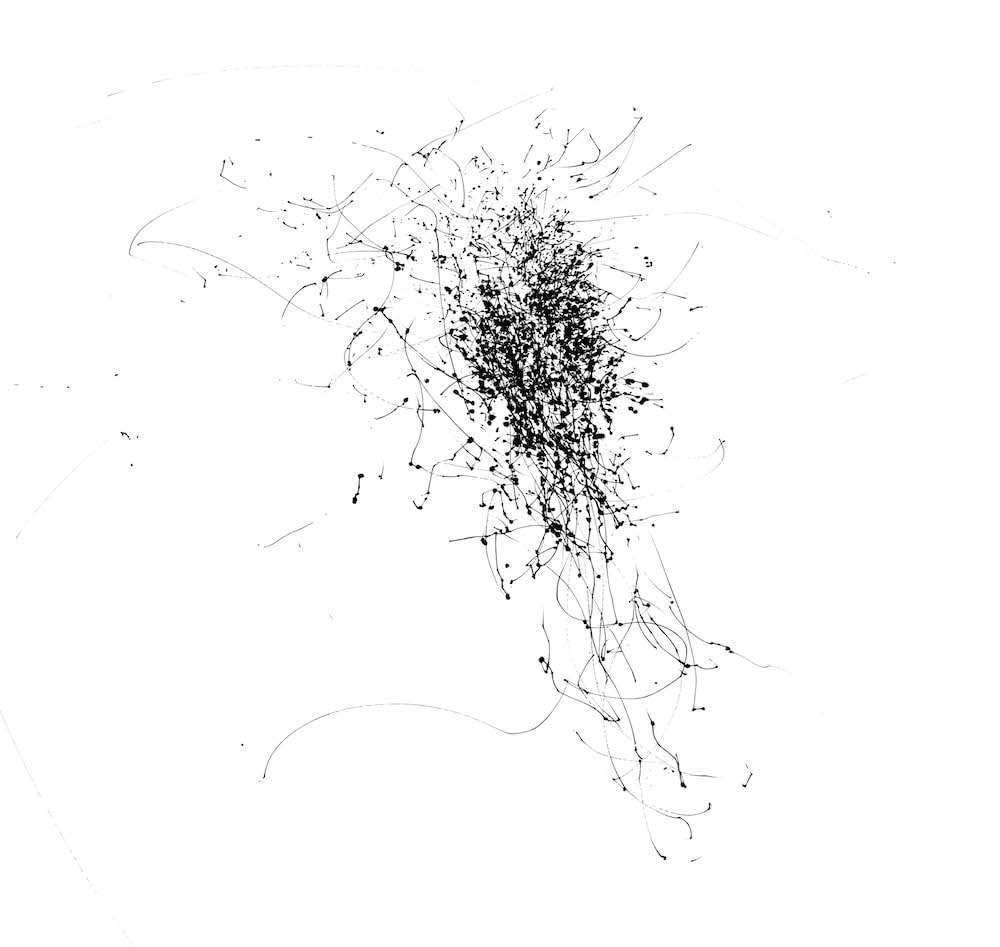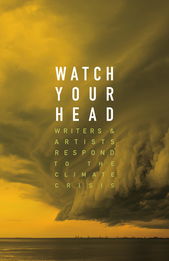|
1/31/2020 PAINTING: ADAM GUNNISLAND OF THE DEAD Rise of the Island of the Dead (2019) Oil on wood panel, 17 X 19 inches (irregular dimensions) After the photo Earth Rise (1968) taken by William Anders, crew of the Apollo 8 mission. Earth Rise is often attributed as being a photograph that contributed immensely to modern environmental awareness. It is predated by black and white photographs taken by an unmanned lunar orbiter two years prior, but it was the blue of the earth taken in Ander’s photo that resonated with millions of people. That brilliant blue contrasts with the dead grey of the lifeless moon and the stark black of the surrounding nothingness, emphasizing the jewel-like fragility of our own world. Island of the Dead (2019) Oil on wood panel, 23.5 X 23.5 inches (irregular dimensions) After the photo Blue Marble (1972) taken by the crew of the Apollo 17 mission. Rückenfigur (2019) Oil on wood panel, 34 X 27 inches (irregular dimensions) After Caspar David Friedrich’s Wanderer Above the Sea of Fog (1818). Friedrich’s painting is often used to represent the Romanticism movement and the sublime. Romanticism was in part a reaction to the industrial revolution marked by a nostalgia for an untouched natural world and a reverence for its overwhelming power. Ironically the spread and continuation of that industrialism is predicted to set in motion a new overpowering version of nature that does not include us. The original painting uses Rückenfigur; a compositional technique with a figure seen from behind contemplating a view before them. In this painting there is no figure; the future view of a dead world is instead seen from behind in time. Garden of Earthly Remains (2019) Oil on wood panel, 21 X 60 inches (irregular dimensions) After Hieronymus Bosch’s The Garden of Earthly Delights (1490 -1510). The five structures in this painting are based off the ones from the center panel of Bosch’s triptych painting. That painting suggests a moral warning about the consequences of a humanity let loose to act without boundaries. In my painting all the abundance of life and wild humanity from that center panel are gone with only the structures remaining. Island of the Dead - Artist Statement This work is focused on a scientific prediction of a change in the colour of the sky and oceans as a result of climate change. I came across this theory through the writings of Professor of Paleontology and Biology at Washington University, Peter Ward. He describes how in the past an increase in carbon dioxide has led to anoxic oceans where hydrogen sulfide producing bacteria altered the chemistry of the environment so that the oceans became purple and the sky became green. I first encountered this scientific prediction in Tim Flannery’s book about the urgent need for climate change action, Now or Never. He quotes Ward from his book Under a Green Sky where he describes a vision of a dead ocean and poisonous sky: Look out on the surface of the great sea itself, and as far as the eye can see there is a mirrored flatness, an ocean without whitecaps. Yet that is not the biggest surprise. From shore to the horizon, there is but an unending purple colour – a vast, flat oily purple, not looking at all like water. . . The colour comes from a vast concentration of purple bacteria. . . At last there is motion on the sea, yet it is not life, but antilife. Not far from the fetid shore, a large bubble of gas belches from the viscous oil slick-like surface. . . It is hydrogen sulphide, produced by green sulphur bacteria growing amid their purple cousins. There is one final surprise. We look upward, to the sky. High, vastly high overhead, there are thin clouds existing far in excess of the highest clouds found on our Earth. They exist in a place that changes the very colour of the sky itself. We are under a pale green sky, and it has the smell of death and poison. As a painter, this change in colour of the world’s landscapes captivated me. The blue of the sky and oceans seems to have always been and as if it always will be. This new colour pallet for the world will be sublime, strange and beautiful, but there will likely be no one around left to see it. Approaching climate change in painting through this change in colour is a phenomenological way to know an issue that is often hard for people to feel convinced of except as an abstract theory. I first came to this subject while working in Berlin last Winter and Spring. I spent a lot of time in Europe visiting museums and seeing historical paintings and contemplating my relationship to them and their relationship to today and came to specifically consider their associations to the environment and climate change. From that research I made a series of paintings referencing historical paintings and images, setting them in that future of purple oceans and green skies predicted by Ward. Adam Gunn is a painter whose work focuses on interests in ideas about natural and unnatural orders with a deep concern for how an image is brought into being. He was both formed and grown in Nova Scotia and currently dwells in Montreal. He has accumulated an MFA from Concordia University and a BFA from NSCAD University. He’s been semi-finalist in the RBC Canadian Painting Competition twice, and recently completed a 5-month residency in Berlin as part of the Nancy Petry Award.
1/26/2020 VISUAL POETRY: SACHA ARCHERTREE SKETCHES Tree Sketches were each composed by a different species of tree. As a writer, connected to story, I felt it a salient action in this time of environmental crisis to step back and listen to the subjects I might otherwise have written over.
Each caption includes the species of trees, both common and Latin names, as well as the duration and date of each composition. Tree Sketches # 1 & 3 were originally published by The Blasted Tree in 2017 as a series of broadsides, while the remaining works are presented on its website, all of them presented under the title The Sign of Poetry. Sacha Archer is a writer who works in numerous mediums as well as being the editor of Simulacrum Press. Archer’s most recent publications include Inkwells: An Event Poem (Noir:Z, 2019), TSK oomph (Inspiritus Press, 2018) and Contemporary Meat (The Blasted Tree, 2018). Houses (No Press), Framing Poems and Mother’s Milk (both Timglaset) are forthcoming. Archer lives in Burlington, Ontario with his wife and two daughters. https://www.instagram.com/sachaarcher/ https://www.facebook.com/sacha.archer https://sachaarcher.wordpress.com 1/26/2020 POETRY: KIM FAHNERREADING THE MURMURATIONS In the end times, they say, the birds might silence themselves, drop feathers as hints, molt at odd times, and mate with their fiercest rivals. But the days will arrive without warning– no bells rung with symbolism, no trumpet voluntary flourish, no drums rolling attendant. They will have already arrived, these muted and too quiet days, dressed in common clothing and pretending to fit in– silencing mothers and lovers as they come, trailing catastrophe in their muddied wake. Kim Fahner was the fourth poet laureate for the City of Greater Sudbury (2016-18), and was the first woman appointed to the role. Her latest book of poems is These Wings (Pedlar Press, 2019). She is a member of the League of Canadian Poets, the Writers’ Union of Canada, and a supporting member of the Playwrights Guild of Canada. Kim blogs fairly regularly at kimfahner.wordpress.com and can be reached via her author website at www.kimfahner.com
|
|
ISSN 2563-0067 © Copyright 2023 | Watch Your Head Contributors Sign up for our Newsletter Buy our print anthology Watch Your Head: Writers & Artists Respond to the Climate Crisis (Coach House Books, 2020). |
